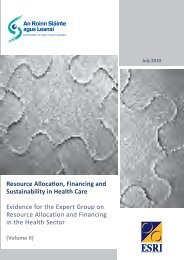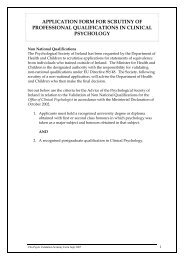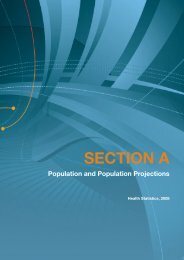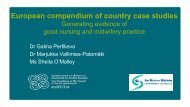Brennan Report - Department of Health and Children
Brennan Report - Department of Health and Children
Brennan Report - Department of Health and Children
You also want an ePaper? Increase the reach of your titles
YUMPU automatically turns print PDFs into web optimized ePapers that Google loves.
Appendix 5Appendix 5DIAGNOSIS RELATED GROUPS/CASEMIXTraditionally, the output <strong>of</strong> hospital services was measured in terms <strong>of</strong> patients treated, sessionsprovided, bed days used or average length <strong>of</strong> stay. While useful in themselves, these indicators<strong>of</strong> activity revealed little about the complexity <strong>of</strong> cases treated, the likely costs involved or therelative efficiency <strong>of</strong> hospitals in managing their caseload. It was recognised that fundinghospitals on an incremental basis, without relating costs directly to complexity <strong>of</strong> activity, wasunsatisfactory since neither equity nor efficiency could be promoted. The first proposals forreforming budgetary allocations to hospitals were made by the Commission on <strong>Health</strong> Fundingin 1989. The Commission recommended that hospitals should receive global budgets for theprovision <strong>of</strong> an agreed service level based on:●●an assessment <strong>of</strong> the activity level implied by the hospital’s agreed role <strong>and</strong> catchmentarea, <strong>and</strong>the casemix-based cost <strong>of</strong> meeting that activity level.In 1991 the <strong>Department</strong> <strong>of</strong> <strong>Health</strong> established a National Casemix Project to select a measurecapable <strong>of</strong> quantifying hospital workload in a way that was meaningful to clinicians <strong>and</strong> managers.The objectives <strong>of</strong> this project were to 1 :●●●●●quantify hospital output in a way that would be meaningful to all participants in the healthcare system, both in terms <strong>of</strong> activity <strong>and</strong> cost;use casemix analysis to promote equity in resource allocation between hospitals;provide hospital management with a means <strong>of</strong> managing resources more effectively;assist in developing mechanisms for monitoring the quality <strong>of</strong> patient care; <strong>and</strong>put in place a system <strong>of</strong> output measurement which would support performance audit inhealth agencies <strong>and</strong> in the <strong>Department</strong> <strong>of</strong> <strong>Health</strong>.The casemix measure chosen assigns all in-patient cases exclusively to one category (known asa Diagnosis Related Group). 2 Each Diagnosis Related Group represents a class or category <strong>of</strong>cases which may be expected to have the same clinical characteristics, receive similar treatment<strong>and</strong> absorb the same amount <strong>of</strong> hospital resources, i.e. physician <strong>and</strong> nursing input, theatre,laboratory, pharmacy, catering <strong>and</strong> cleaning costs.Wiley <strong>and</strong> Fetter (1990) 3 demonstrated that this casemix measure could be appliedsuccessfully to Irish hospital discharge data, collected through the Hospital In-patient EnquirySystem. The Hospital In-patient Enquiry system is the national database for all acute hospitaldischarges which records demographic data, hospital stay information, diagnostic data <strong>and</strong> dataon procedures performed for each discharged patient. The information system was <strong>and</strong> istherefore in place for the collection <strong>of</strong> the casemix measurement activity data.Estimates <strong>of</strong> the casemix budget adjustment draw on two main data sources: hospital activitydata (from the Hospital In-patient Enquiry system) <strong>and</strong> hospital cost data.The hospital cost dataare submitted to the <strong>Department</strong> <strong>of</strong> <strong>Health</strong> <strong>and</strong> <strong>Children</strong> through a ‘Speciality Costing’ system.This system has been operating within the <strong>Department</strong> <strong>of</strong> <strong>Health</strong> <strong>and</strong> <strong>Children</strong> for a number <strong>of</strong>1Casemix Manual, 1993, <strong>Department</strong> <strong>of</strong> <strong>Health</strong>.2Diagnosis related groups were developed by a team <strong>of</strong> researchers at Yale University led by Fetter,Thompson <strong>and</strong> Brown(1994).The development <strong>of</strong> diagnosis related groups was motivated by the need for a utilisation review, m<strong>and</strong>ated by the 1965Medicare law on payment <strong>of</strong> elderly patients in hospitals (Rodrigues, 1989).3Wiley, M.M., <strong>and</strong> Fetter, R. Measuring Activity <strong>and</strong> Costs in Irish Hospitals:A Study <strong>of</strong> Hospital Casemix, Dublin, 1990.175
















